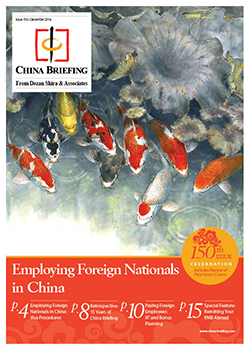Special Feature: Remitting Your RMB Abroad
Almost all foreigners employed in China run into the problem sooner or later. They are getting paid in RMB and want to send some of their salary back home, either for bills and payments to be made abroad, or to transfer their savings out of China before moving back to their home country.
The hard part? China has limitations in place on how much RMB you can convert into and from foreign currencies, as well as how much money you can send abroad. The related regulations operate under the assumption that the only way a foreigner could have accumulated RMB is by either having previously exchanged foreign currency into RMB, or from legal sources of income in China.
Remitting salary
To remit RMB earned from employment in China, you will need to be able to show the bank that the amount of RMB in question was obtained legally and that all related taxes have been paid up, or was previously converted from a foreign currency into RMB.
You will also need to show the bank your labor contract, work permit, pay slips and a tax certificate saying that tax has been paid on the income – which can be obtained at your
local tax bureau. As well, if you have sold real estate in China, you will need to show the contract of sales and again, a tax certificate.
Remitting forex transactions
To convert RMB derived from a foreign exchange transaction, you must provide the receipt issued by the bank when you changed the foreign currency into RMB. However, only a receipt from the past 24 months is considered valid. If the transaction amount on the day in question was less than the equivalent of US$500 in RMB, there is no need to show a previous receipt.
The problem arises when, for whatever reason, you are not able to provide the bank with
the above documents. In that case, foreigners are limited to sending the equivalent of up to US$500 abroad per day. Apart from being a hassle, the transaction and exchange fees can add up to a significant amount, cutting into one’s savings in China.
Other options
When leaving China, an individual may bring up to RMB 20,000 in cash across the border, while for foreign currencies, the regulations are similar to those in any other country. Additionally, there is no limit on how much foreign currency one can remit abroad. You can open a foreign currency bank account with a local bank, into which the equivalent of US$5,000 can be deposited per day. If you are able to convert your RMB outside the bank, for example by changing money with a friend, this could be another way to move some of your money abroad.
Otherwise, some foreigners may find success in entrusting a Chinese friend to remit their RMB to a foreign account for them. Chinese citizens may remit up to the equivalent of US$50,000 every year. The Chinese friend may use some or all of this allowance to convert the currency, and send the money to your account abroad.
![]() RELATED: Getting Money Out of China: Macau Casinos, Xinjiang Jade and French Wines?
RELATED: Getting Money Out of China: Macau Casinos, Xinjiang Jade and French Wines?
The Macau Route
In recent years, many Mainland Chinese (and some foreigners as well) have found an illegal loophole to take cash out of the country. As described by a Bloomberg exposé,
they use their UnionPay bank cards to make fake purchases at pawn-shops and jewelry stores in Macau. The receipts will say that the customer has purchased an expensive item, whereas in reality the shop owner gives the customer the transaction amount in Hong Kong Dollars or Macau Pataca, the two freely convertible currencies used in Macau. Estimates as to the amount of money funnelled through this channel to date run in the billions of U.S. dollars.
As the above demonstrates, for foreign nationals working in China, it pays to be prepared for how you will eventually move your RMB out of the country. Investors are advised to contract the Business Advisory Services of Dezan Shira & Associates to ensure the compliance necessary to allow your employees to hold onto their hard-earned savings.
 This article is an excerpt from the December issue of China Briefing Magazine, titled “Employing Foreign Nationals in China“. In this issue of China Briefing, we have set out to produce a guide to employing foreign nationals in China, from the initial step of applying for work visas, to more advanced subjects such as determining IIT liability and optimizing employee income packages for tax efficiency. Lastly, recognizing that few foreigners immigrate to China on a permanent basis, we provide an overview of methods for remitting RMB abroad. This article is an excerpt from the December issue of China Briefing Magazine, titled “Employing Foreign Nationals in China“. In this issue of China Briefing, we have set out to produce a guide to employing foreign nationals in China, from the initial step of applying for work visas, to more advanced subjects such as determining IIT liability and optimizing employee income packages for tax efficiency. Lastly, recognizing that few foreigners immigrate to China on a permanent basis, we provide an overview of methods for remitting RMB abroad. |
![]()
 Strategies for Repatriating Profits from China
Strategies for Repatriating Profits from China
In this issue of China Briefing, we guide you through the different channels for repatriating profits, including via intercompany expenses (i.e., charging service fees and royalties to the Chinese subsidiary) and loans. We also cover the requirements and procedures for repatriating dividends, as well as how to take advantage of lowered tax rates under double tax avoidance treaties.
 Social Insurance in China
Social Insurance in China
In this issue of China Briefing Magazine, we introduce China’s current social insurance system and provide an update on the status of foreigners’ participation in the system. We also include a comprehensive chart of updated average wages across China, which is used to calculate social insurance contribution floors and ceilings. We hope this will give you a better understanding of the system in China.
 The China Tax Guide: Tax, Accounting and Audit (Sixth Edition)
The China Tax Guide: Tax, Accounting and Audit (Sixth Edition)
This edition of the China Tax Guide, updated for 2013, offers a comprehensive overview of the major taxes foreign investors are likely to encounter when establishing or operating a business in China, as well as other tax-relevant obligations. This concise, detailed, yet pragmatic guide is ideal for CFOs, compliance officers and heads of accounting who need to be able to navigate the complex tax and accounting landscape in China in order to effectively manage and strategically plan their China operations.
- Previous Article Obtaining a Multi-Year Employment Permit in China
- Next Article Human Resources and Payroll in China 2015 – New Publication from China Briefing


























